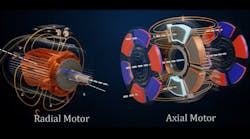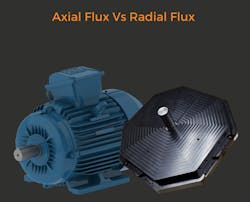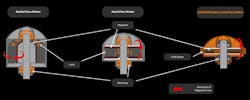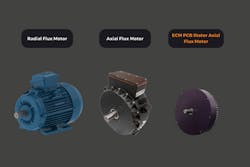What you’ll learn:
- What sets axial- and radial-flux electric motors apart?
- The pros and cons of axial flux and radial flux in serving the surging global electric-motor market demand.
As the world rapidly electrifies, demand for specialized motors is exponentially ramping up. That’s because more of the devices we use in business and daily life are electrifying, too. And from e-mobility to consumer electronics, all of those devices need electric motors to operate.
As a result, global electronics designers are delving deeper into electric-motor topology. Quite frequently, that research leads to this question: “What’s the difference between axial-flux and radial-flux electric motors?”
That’s understandable since axial-flux motors and radial-flux motors are common classes of electric motors. Both convert electrical energy into mechanical energy, but they differ substantially in design and assembly. Detailed comparisons of axial versus radial flux have been done, usually landing on the conclusion that each has its pros and cons.
Radial-flux motors have been around longer and are more frequently found in legacy electric systems.
However, over the past few decades, axial-flux motors have become more prevalent due to the advantages they offer over their radial counterparts. Some of these benefits weren’t feasible with legacy manufacturing methods and materials. However, new technology design platforms have expanded the advantages of axial-flux topology to a broader range of users and applications.
This has been especially true within the e-mobility and electric-vehicle (EV) space, as both American and European auto manufacturers have explored the potential upsides of using axial-flux motors in their drive systems.
So, What are the Big Differences Between Axial and Radial?
The main difference between axial and radial motors has to do with their magnetic fields.
In axial-flux motors, the magnetic field is parallel to the shaft and the windings are arranged in a planar fashion. This design allows for a more compact motor, with shorter axial length and a disc, rather than cylindrical, form factor. In a radial-flux motor, the magnetic field is perpendicular to the shaft and the windings are arranged in a cylindrical fashion. This design is typically larger and bulkier.
In general, the major difference (and benefit) shared by all axial-flux machines is that flux has a more direct path compared to a radial-flux machine. This makes the magnetic circuit simpler and perhaps easier to implement, with low losses. However, since the poles in the axial-flux machine are shaped like sections of an orange, the electric circuit path on the outer end turn is more onerous. A radial-flux machine has the dual advantage.
In exchange for a more tortuous magnetic circuit path, the end-turn penalty in the electric circuit is less. An axial-flux machine incorporating a more thermal and conductive printed-circuit-board (PCB) stator allows for more design optimization, both in terms of performance specs and customizable form factor. Wire-wound axial-flux machines don’t have this advantage.
Benefits of Axial-Flux Topology
In addition to being a more compact motor, axial-flux motors offer many advantages over radial-flux machines. Some of those include:
- Lightweight construction
- High power density
- High torque-to-weight ratio
- Increased energy efficiency
- Reduced raw material usage
- Greater design flexibility
Unsurprisingly, a number of these benefit categories share a symbiotic relationship. For example, the increased torque density in axial-flux motors is achieved by their pancake-like design, larger diameter, and shorter axial length. These characteristics support weight savings and higher torque-to-weight ratios of axial-flux machines. This, in turn, allows axial-flux electric motors to deliver more power in a compact package.
In addition, the inherently thinner axial length of axial-flux motors creates new possibilities for integrating them within electric systems. These novel arrangements can positively alter the form-factor constraints on other elements within the system.
For example, several EV applications have successfully consolidated axial-flux motors entirely within wheel housings, creating additional space for batteries to extend range. Similarly, these motors in defense and aerospace applications offer options for additional sensors and room for larger payloads.
Billions of Electric Motors
In the broader scheme of things, a confluence of trends has shifted greater focus on this topic of differences, pros, and cons between axial flux and radial flux machines.
Macro currents—such as mass electrification and automation—are pushing global demand for specialized electric motors to over a billion units annually in a sector valued at over $200 billion. This booming electric motor demand is occurring in a long list of verticals: HVAC equipment, e-mobility, consumer electronics, household appliances, robotics, medical devices, aerospace, defense, and unmanned vehicles—you name it.
Then there’s a frequently overlooked facet of the energy sustainability challenge—the world’s electric-motor sustainability problem. Research underscores that outdated electric-motor systems account for over 40% of global energy consumption.
Add it all up and there’s a need to design more electric motors than ever before with improved performance, efficiency, and optimization.
The introspection occurring in this space reveals many electric-motor use cases that can benefit from axial-flux topology. Some common household applications of note include heating and cooling systems (e.g., pumps and fans), kitchen devices (e.g., blenders and coffee machines), power and yard tools (e.g., drills and lawnmowers), home appliances (e.g., washing machines and dishwashers), and other typical household items that aren’t as obvious (e.g., exercise bikes and baby rockers).
The most direct benefits to these household applications from axial-flux motors include:
- Longer battery life and cheaper electricity bills (derived from higher efficiencies)
- Greater product reliability and longer product lifecycles
- A slim form factor allowing for sleeker and more affordable products that are less costly to design, produce, and distribute
In addition, many new innovations can benefit from axial-flux motors. Among them are wind turbines, due to the low profile and high torque-to-weight ratio, as well as medical bionics and advanced cinematography, due to the quality of motion and controllability. Industrial automation, such as robotics and conveyors, also benefit thanks to the motors’ durability and flexible form factor.
The EV space is innovating with and adopting axial-flux topology, too. Both Mercedes Benz and Ferrari are integrating axial-flux electric motors into their concept and high-performance EVs, touting the benefits of compact size, high-power density, and greater efficiency.
Within this conversation, there’s a broader question: “How to satisfy global demand for over a billion specialized electric motors annually—with more of them requiring axial-flux topology—across thousands of applications?”
Taking Advantage of Motor CAD
In ECM’s view, the answer comes down to two factors: better technology and advanced Motor CAD offered via software as a service (SaaS). On the tech side, the company has specialized in design of axial-flux, air-core, printed-circuit-board—PCB Stator—electric motors. ECM’s PCB Stators replace the copper windings found in conventional electric machines with an ultra-thin stator.
On the software side, ECM developed a Motor CAD platform, PrintStator, that enables enterprises, innovators, and engineers to design, market, and commercialize axial-flux machines that are smaller, quieter, and more energy and space efficient.
PCB Stator motors designed via PrintStator are up to 70% lighter than traditional options while achieving efficiencies in the mid-90s, and requiring just 20% of the raw materials over conventional machines, according to ECM.
As a design tool, PrintStator enables users to create complex electric-motor designs from any set of motor parameters. The software uses proprietary design algorithms to quickly develop axial-flux, PCB Stator motor solutions and provides a range of customization options. These include motor dimensions, voltage/current restraints, performance specifications, target efficiency, and integration of the specific magnetic material.
To scale this capability more broadly, PrintStator’s SaaS model makes it possible for any consumer electronics innovator—from startup entrepreneur to big-company engineer—to become an electric-motor designer and producer. The SaaS model extends options for vertical integration and production to large and small industry players.
In the long run, advanced Motor CAD via SaaS could be the most viable means to meet the world’s surging electric-motor needs at scale. That extends to the increasing demand for those of the axial-flux variety.





